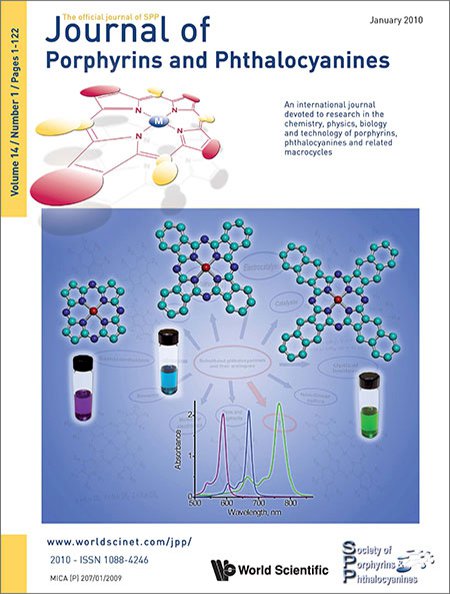System Upgrade on Tue, May 28th, 2024 at 2am (EDT)
Existing users will be able to log into the site and access content. However, E-commerce and registration of new users may not be available for up to 12 hours.For online purchase, please visit us again. Contact us at customercare@wspc.com for any enquiries.
Volume 14, Issue 01 (January 2010)
The key role of peripheral substituents in the chemistry of phthalocyanines and their analogs
- Pages:1–40
https://doi.org/10.1142/S1088424610001799

General strategies for the preparation of peripherally substituted phthalocyanines, naphthalocyanines, anthracyanines, aza-analogs of phthalocyanines, and tetraazaporphyrins have been discussed. An influence of the types and positions of the substituents attached to the macrocyclic core on the optical properties of these compounds has been generalized. In many cases, poorly known methodologies, published in mostly unavailable Russian journals, were highlighted throughout this review.
Syntheses and structural studies of η5-pentamethylcyclopentadienyl rhodium(III) and iridium(III) complexes of a Schiff-base expanded porphyrin
- Pages:41–46
https://doi.org/10.1142/S1088424610001738

The synthesis of new binuclear rhodium(III) and iridium(III) semi-sandwich complexes of a Schiff-base expanded porphyrin is reported here. Single crystal X-ray diffraction analyses and complementary NMR studies provide evidence for the existence of strong intramolecular hydrogen-bonding interactions between the pyrrolic NH protons and the chloride ligand both in dichloromethane solution and in the solid state.
Synthesis of near-infrared absorbed metal phthalocyanine with S-aryl groups at non-peripheral positions
- Pages:47–54
https://doi.org/10.1142/S1088424610001726

The target compounds were synthesized: 15 phthalocyanines from 2, 3-dicyanohydroquinone in 3 steps via 1,2-dicyanobenzene-3,6-bis-(trifluorate) and 1,2-dicyanobenzene-3,6-thiophenols. The Q bands of obtained compounds appeared in the near-infrared region. In particular, 1,4,8,11,15,18,22,25-octakis(thiophenylmethyl)phthalocyaninate lead shows a Q band at 857 nm. Furthermore, non-colored transparent films in the visible region can be produced.
Through space singlet energy transfers in light-harvesting systems and cofacial bisporphyrin dyads
- Pages:55–63
https://doi.org/10.1142/S1088424610001702

This review focuses on the photophysical processes and dynamics in the light harvesting devices, notably LH II, in the heavily investigated purple photosynthetic bacteria, and compares these parameters with our cofacial bisporphyrin dyads build upon octa-etio-porphyrin chromophores and rigid and semi-rigid spacers.
Photooxidation of phenol derivatives using μ-(dihydroxo)dipalladium(II) bisporphyrin complex
- Pages:64–68
https://doi.org/10.1142/S108842461000174X

δ-(dihydroxo)dipalladium(II) complex with N21, N22-etheno bridged tetraphenylporphyrin ligand was employed in the catalytic photooxidation of phenol derivatives in aerated homogeneous solution with visible light irradiation. The Pd complex promoted degradation of p-tert-butylphenol and selective photooxidation of some phenol derivatives to afford the corresponding quinones. This Pd complex showed higher light durability compared with ordinary porphyrin free base and its Pd complex.
Morphology and radical reactions of Cu(II) and Co(II) sulfonated phthalocyanines covalently linked to poly(ethyleneamide)
- Pages:69–80
https://doi.org/10.1142/S1088424610001751

The tetrasulfonated CuII(tspc)4-, tspc = 4,4‣,4″,4‴-phthalocyaninetetrasulfonate, and the trisulfonated CoII(trspc)3-, trspc = n,n‣,n″-phthalocyanine- trisulfonate where n, n‣ and n″ indicate the sulfonated positions of the various isomers, were covalently linked to a poly(ethyleneimine). The redox reactions of the phthalocyanine pendants with pulse radiolytically generated radicals (e-sol, C∙H2OH, (CH3)2COHC∙H2, CO2∙-, N3∙ and SO4∙-) produce phthalocyanine radicals, Cu(I) and CoIII-hydroxyalkyl reaction intermediates.
Porphyrin self-assembled monolayers and photodynamic oxidation of tryptophan
- Isabelle Chambrier,
- David A. Russell,
- Derek E. Brundish,
- William G. Love,
- Giulio Jori,
- M. Magaraggia, and
- Michael J. Cook
- Pages:81–88
https://doi.org/10.1142/S1088424610001696

Self-assembled monolayer (SAM) films of purposely synthesized zinc and magnesium diporphyrin derivatives, 1b and 1c, have been deposited on the surface of gold-coated glass substrates. The SAM films were characterized by RAIR and fluorescence spectroscopy. The potential for the films to promote the oxidation of tryptophan within human serum albumin upon irradiation with white light has been demonstrated and attributed to the porphyrins acting as photosensitizers of oxygen to form oxidizing species.
Efficient synthesis of an A-B-C-tricycle fragment for a structural model of tolyporphin
- Pages:89–100
https://doi.org/10.1142/S1088424610001763

This paper is no longer available. Please contact "jpp@wspc.com" S1088424610001775
Synthesis and self-assembly of a novel cobalt(II) porphyrin lipoic acid derivative on gold
- Pages:101–107
https://doi.org/10.1142/S1088424610001775

Synthesis, characterization and electrochemistry of the novel metalloporphyrazines annulated with tetrathiafulvalene having pentoxycarbonyl substituents
- Pages:108–114
https://doi.org/10.1142/S1088424610001787

Three novel tetrathiafulvalene-annulated metalloporphyrazines with electron-withdrawing pentoxycarbonyl groups at the periphery were synthesized via the cyclotetramerization of dipentyl 6,7-dicyanotetrathiafulvalen-2,3-dicarboxylate in the presence of corresponding metal salts (Zn(OAc)2·2H2O, Cu(OAc)2·2H2O and NiCl2) and in pentanol. Solution electrochemical data showed one reductive and three oxidative processes within a -2000 mV to +2200 mV potential window.
Inter-ring interactions in [Fe(TalkylP)(Cl)] (alkyl = ethyl, n-propyl, n-hexyl) complexes: control by meso-substituted groups
- Pages:115–122
https://doi.org/10.1142/S1088424610001714

We report syntheses, molecular structures and magnetic susceptibilities of three meso-substituted high-spin iron(III) porphyrinate complexes ([Fe(TEtP)(Cl)], [Fe(TPrP)(Cl)], and [Fe(THexP)(Cl)]). It was determined that the inter-ring interactions within each dimeric unit change upon alteration of the alkyl groups at the meso positions. Magnetic exchange couplings between iron centers of the dimers are in accord with the trends in structural inter-ring geometries.



